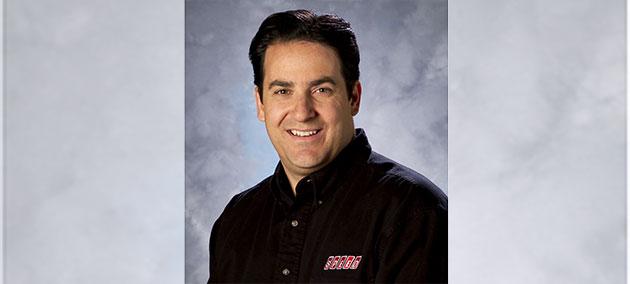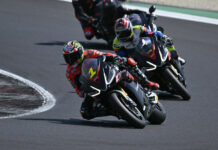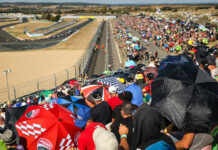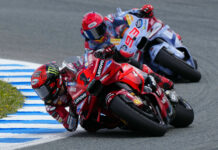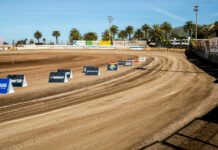DENVER, Colo. – M1 PowerSports caught up with veteran motorsport broadcaster Ralph Sheheen as he headed to the airport to fly down to Daytona Beach, Florida, where he will be a part of the TNT broadcast team for this weekend’s Coke Zero 400 at Daytona International Speedway. Sheheen has been a broadcaster on live national TV since 1988; in his 24 years in the field he has covered everything from swamp buggies to Formula 1 and from trials competition to MotoGP. His versatility has allowed him to cover all aspects of motorsport, and his latest role as the Owner/Publisher of National Speed Sport News will allow him to capitalize on the strengths gained during his long and storied career. Following the completion of his NASCAR tour with TNT at New Hampshire, Sheheen will be back to the bikes with play-by-play of MotoGP and AMA Pro National Guard SuperBike from Mazda Raceway Laguna Seca. M1: What is a typical day in the life of Ralph Sheheen? RS: It’s always preparing to get back in front of the camera, that’s a never ending job. To be a good race broadcaster, it’s 24/7, 365 days out of the year that you’re always doing something to prepare. Now, that might be reading a magazine, or studying up on something that you find on the internet, or making your notes, or talking to somebody on the phone, it could be one of 1000 different things but they all relate to getting yourself prepared for the next broadcast. On top of that, with my new ownership of National Speed Sport News, whatever little bit of free time I had has been devoured by that. M1: How did you spend your July 4 this year? RS: July 4 itself was spent relaxing with my family around the pool at my in-laws in New Smyrna Beach, Florida. It was the first time in a while that I was able to just relax with the kids. It was nice, swimming around the pool and being with friends and family and doing all that, but as I just said, 24/7/365 I am doing racing prep work and yes, I did spend a good bit of time while I was relaxing reading up on my favorite racing publications and loading up on more racing knowledge. M1: How did the National Speed Sport News deal come about? RS: Well, National Speed Sport News was a very famous brand when it came to motorsport journalism in the United States; it was considered to be the bible of racing in America for decades. It started in 1934 as a weekly newspaper that the great Chris Economaki ran for many years covering strictly four wheel racing. It ceased publication a year ago and I was given the opportunity by the Economaki family to take over and relaunch the brand. M1: What changes have you made to the National Speed Sport News concept? RS: Along with my partners, Joe Tripp and Curt Moon, I knew that we had to come up with a new plan for the new digital age. We came up with a plan to take the weekly newspaper and turn that into a leading website, NationalSpeedSportNews.com. We have a daily email update that we send out every morning that gives you the top stories from the night before, whether its race results, recaps or the latest news. We have SPEED SPORT magazine, which is available as a hard copy or a digital version on iTunes if you’d rather read it that way. That magazine comes out monthly, and takes everything from the website and goes bigger, broader and deeper. Keeping up with the social media trends, we have Facebook and Twitter and we also have SPEED SPORT on FOX Sports Radio, which is available in 250 markets and 177 countries, it’s on iHeartRadio as well as XM Radio. We have quite a few different layers as to how we distribute the news in the racing world. M1: Has the coverage changed at all since the relaunch? RS: The biggest difference, for fans of AMA Pro Racing, is that we have added complete motorcycle coverage alongside our car coverage. We are the only place on the Internet, the only publication, as well as the only radio show, which covers literally all forms of racing, from the top professional ranks of MotoGP, Formula 1 and NASCAR down to what happened last night at your local dirt track, whether it was on two wheels or four. M1: Over the years you have formed solid relationships on both the four-wheeled and two-wheeled sides of racing. How did you get to know the guys from M1 PowerSports? RS: Gosh, it goes back so far now, it’s hard to remember where and when it all began. But from the very beginning, Cameron [Gray] and I-San [Hung] and myself had an immediate connection as far as our appreciation for motorcycle racing goes; what these athletes do, what’s involved to put on great events and having a desire to see American motorcycle racing achieve the highest level that it possibly can. When you talk about the quality of the show that’s put on for the race fans, whether it’s on TV or at the event site, we’ve had that mutual common ground as far as how we feel about how things should be done and how we can improve on them. We’ve always shared lots of conversations, some of them at each other’s houses, some of them in the mountains over Colorado, some of them over a beer in the paddock after things are done, always pushing what we thought could happen to help each other achieve these goals in our respective industries. M1: What impact do you see on the sport of motorcycle road racing with the return of M1 PowerSports to full-time promotion of AMA Pro Road Racing Nationals? RS: We’ve become just the best of friends, the three of us, so I’m thrilled to see M1 become even bigger and stronger with the addition of their three AMA Pro Road Racing events this year. Their Big Kahuna Triple Crown deal is put together and promoted the way that AMA Pro Road Racing needs to go. It’s just good for the sport in general. These guys are enthusiastic, they’re hungry and they get things done. There are some very strong promoters out there already and I think adding the new vision that M1 has will help to elevate the sport, which will make it better for everybody, better for the riders, better for the sanctioning body and better for the other promoters, because it’ll bring new life into the sport. And ultimately, M1’s involvement is going to make it better for the race fan, and that’s the most important part. M1: I heard a rumor about Cameron’s energy bars and one of your dogs, can you tell us about that? RS: Yeah, okay… [laughs] With any great friendship there are always challenges that you have to overcome. My wife Kimberley had a dog named Cassidy, she had had Cassidy since she was six weeks old. Cassidy was a cocker spaniel, the head dog in our house of three. She was an old girl, probably 15 at the time. Cameron and I-San came to visit, and Cameron was staying in one of the guest rooms. He was in a fitness binge, where he was doing one of his crazy diets and workout regimens and all of these other things that Cameron does. He had left his carryon bag on the floor of the room and in the bag there was a zip lock bag full of all of these different bars, energy foods and dietary supplements and you name it. Well, we had all gone out and when we came home we discovered that Cassidy, like most 15-year-old dogs would do, got a sniff of something and went digging. She found the bag and didn’t just rip the bag open and eat one, she inhaled the entire bag. When we came home we had a cocker spaniel that looked like she had swallowed a basketball. We of course took her to the vet and they had to cut her open and remove all of the contents out of this poor 15-year-old cocker spaniel’s belly. Sadly, not necessarily from that occurrence, but sadly shortly thereafter due to her age Cassidy passed away. But being the kind of friends we are, I have and will continue to put all of the blame on Cameron because it’s an easy knife to turn in him. M1: What is your favorite racing experience from the two-wheeled world? RS: I think on the two-wheeled side, one of my greatest memories as a broadcaster came when I was just working as a PA announcer. This was at Mazda Raceway Laguna Seca, the first year that the 500GP Championship came to the US. I remember a couple of things from that day; one was Jimmy Filice winning the 250 race and the surprise he gave everyone, because he was a wildcard entry added the week before riding an Erv Kanemoto bike. Nobody outside of those of us that followed AMA racing knew who he was, and here was this young guy that just stunned the best 250 riders in the world. And he didn’t just win; he absolutely smoked them that day. I remember that as they were playing the national anthem, Jimmy was just crying because of what he had just done. I was and still am good friends with Jimmy Filice, and it was just so important to him. Then shortly thereafter, Eddie Lawson won the 500 race and made it a sweep for the Americans. After the race was over, I remember Lawson stopping in corkscrew and throwing basically everything he owned over the fence to the fans and then hearing the entire race track singing the national anthem. It was a very emotional day for every American that was there, seeing what would become some of the greatest road racers that our country has produced get the opportunity to beat the best in the world and doing it for the first time at home. M1: You’ve also worked with the best of the best in auto racing, what memory comes to mind in that realm? RS: One of my best memories is working the 1997 Daytona 500 and Dale Earnhardt Sr. flips going down the backstretch near the end of the race. He gets out of the car, into the ambulance and looks out. He sees that the wheels are still on the car, so he gets out of the ambulance and back in the car, pulls around into pit lane, gets new tires and goes out, losing yet again at Daytona. While [Jeff] Gordon is in victory lane I went running to interview Earnhardt. He was in the middle of a crowd of reporters, as was usual for Dale, and I was working as a reporter and was about to go live on CBS. So I dove in the pile, and he goes “What do you need?” I told him, “I need to interview you, but my camera just went down.” So he says, “Follow me to my hauler.” Then he grabbed my belt loop and away we went. When we got back to hauler, Dale stood up on ice chest and told the crowd of reporters, “I’m not doing any interviews until I’m done talking to Ralph. Once he’s done, then I’ll talk to you guys, so hold on a minute.” My camera came back up, and we had all these people surrounding us and then CBS went to a commercial break. “What are they doing now?” Dale asked. I told him, “You know that beer commercial where you’re walking around the racetrack, they’re playing that now from Daytona.” Dale starts telling me all about the day they filmed the commercial; remember that this is a man that just flipped down the backstretch at 200mph. TV came back and they threw it down to me, I did the interview, thanked him and he said “No problem,” and then he went on and answered all the rest of the reporters’ questions. It was a great feeling, with all of those people standing around and it was just Dale Earnhardt and I sitting there talking about him shooting a beer commercial. I have a lot of special memories of Sr. that I’ll remember for a long time. M1: Any other memories of Dale Earnhardt, Sr. that really stand out from your years broadcasting NASCAR events? RS: I wasn’t actually on the air, but I had just moved to Charlotte and was doing some PR work on the side to supplement my income while I was chasing my broadcasting career, and I had to go with Sr. to an autograph signing that he was doing. The session was somewhere in Pennsylvania, so we were going to fly up in Dale’s plane. I had to drive the Chevy Suburban to the airport, and I had never driven one, I always had sports cars. So here I am driving this big ole vehicle and I have one of the best race car drivers in the world in the seat to my right. We’re on this two-lane backcountry rode in North Carolina, and this is before GPS so I’m just going wherever he tells me to go. We’re going along pretty good, closing in on semi, and I’m about 100 yards behind him when I hear the engine go WOOOO. I look down and, sure enough, here’s this size 12 cowboy boot planted firmly on my tennis shoe. I look over to my right and there’s Big E with his sunglasses on, just looking at me, not saying a word. The look on his face said “Okay, what are you gonna do kid?” Well, I know I can either beg for him to lift his foot and he’ll never speak to me again, or I can just try to hope that when we come around the side of this semi everything is clear, otherwise we’re going to make headlines in every paper in the country and I’ll be the one to blame. I pulled around to pass the semi, we came over the crest of a hill and another car was coming, and we just made it. Dale Earnhardt and I never spoke one word about that moment as long as we knew each other, but I passed his test that day and so he always granted me whatever I needed as far as an interview or just chatting on the back of a truck. He always challenged you, and once you knew what the game was and that you had to pass, you had to do it, no matter what it was, because if you didn’t, in his mind you were marked. And I knew that, so I always did whatever I had to do to pass the test, no matter how uncomfortable it might have been to get through it. To spin that forward, that’s why I always kind of laugh when someone says to me: “Watch out for that guy, he’s a pretty tough interview.” My response: “Really? You didn’t know Dale Sr. then.” I have yet to interview anybody that was a tougher interview than Dale Earnhardt Sr. Let me tell you something, he earned that moniker The Intimidator in a lot of ways, not just by what he did behind the wheel. It was on the track, off the track, how he dealt with the media, he was intimidating. But he was also one of the softest people; I could talk for 3 hours about some of the charitable things that he did in his lifetime that fans would have no idea about, things that he cared about but didn’t want people to know about because it wasn’t his image. Nobody except for those that were closest to him really knew about all of the great things he did until he passed and then people started exposing what really made the man tick, and it’s pretty amazing. But, if I had not passed that test in the Chevy Suburban, I never would have gotten another interview out of Dale Earnhardt, Sr. For tickets and information about the Big Kahuna Miami, scheduled for September 21 – 23, 2012 at Homestead-Miami Speedway in Homestead, Fla., visit ~http://www.m1powersports.com/big-kahuna-miami/~. For tickets and information about the Big Kahuna New Orleans, scheduled for October 5 – 7, 2012 as the first professional motorsports event at NOLA Motorsports Park in New Orleans, La., visit ~http://www.m1powersports.com/big-kahuna-new-orleans/~. About M1 PowerSports, formerly M1 Entertainment: A Denver-based company, M1 PowerSports has been working in motorsports for over 16 years. Originally spawned from Daniels Corporation under the name FAST, the fledgling company was heavily involved in television production for car and motorcycle racing. With the birth of Speedvision, FAST morphed into Race Promotion Management (RPM) and is now operating as M1 PowerSports with many of the same staff still in place. We still sell advertising for Speed, sell merchandise under the brand Moto 1 and promote our own events, keeping us busy year-round! For more information, please call 303-377-3278 or email [email protected].
M1 PowerSports Presents: A Conversation With Motorsports Broadcaster Ralph Sheheen
M1 PowerSports Presents: A Conversation With Motorsports Broadcaster Ralph Sheheen
© 2012, Roadracing World Publishing, Inc.
